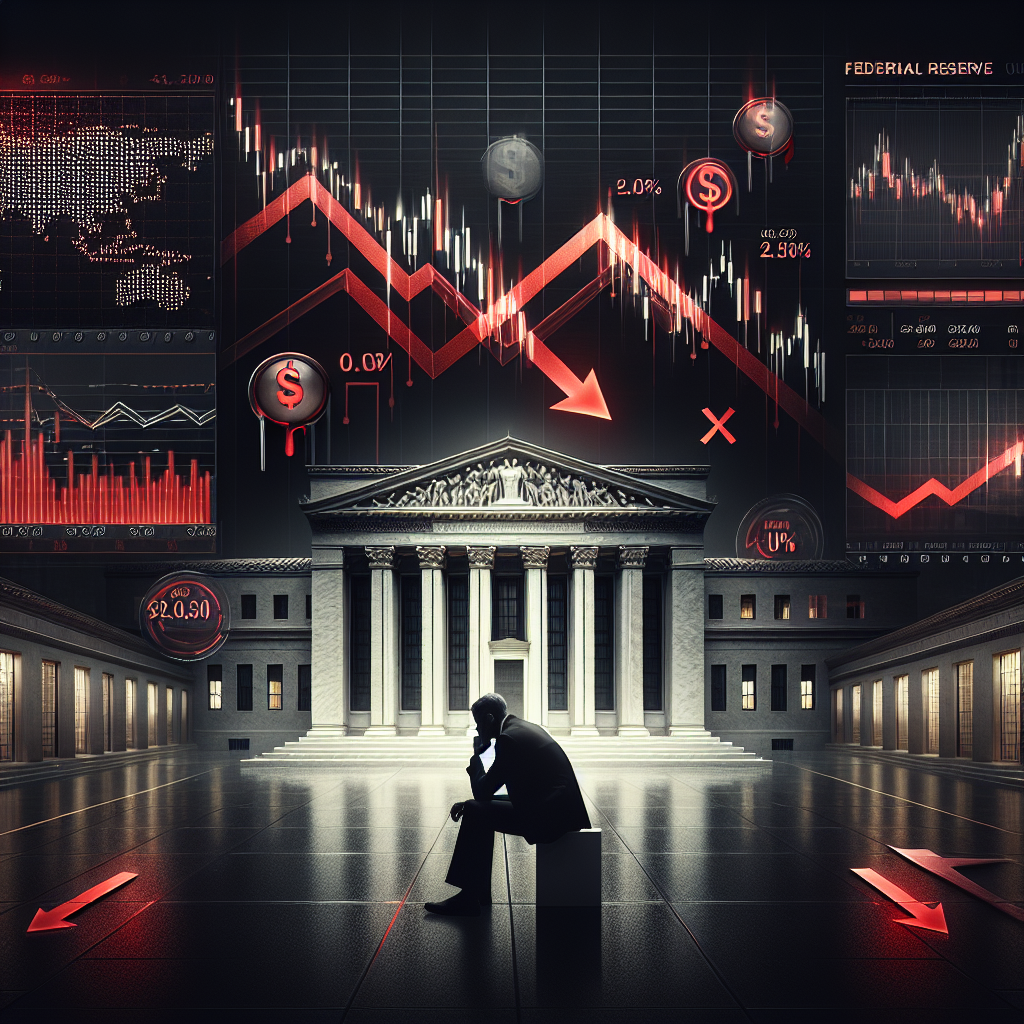
On November 25, 2024, the U.S. stock market faced a significant downturn, with the S&P 500 and Nasdaq Composite indices both sliding sharply. This sudden pullback came in response to the latest inflation data from the Federal Reserve. Investors were particularly concerned about the report showing that progress toward the Fed’s inflation targets had faltered, signaling that inflation may remain persistently high despite aggressive monetary tightening over the past year.
The release of the Personal Consumption Expenditures (PCE) price index, which the Federal Reserve uses as its primary inflation measure, caused significant market volatility. This index, which tracks the price of goods and services consumed by individuals, showed that inflation was still not on track to meet the Fed’s 2% target, leading to investor uncertainty. This article delves into the reasons behind the stock market decline, what the inflation report reveals, and what it means for investors and the economy moving forward.
S&P 500 and Nasdaq: Market Overview
On the trading day following the Fed’s inflation report, the S&P 500 dropped by about 1.2%, and the Nasdaq Composite, which is heavily weighted towards technology stocks, saw an even sharper decline of 1.5%. While the S&P 500 includes a broad range of sectors, the Nasdaq’s technology-heavy composition made it particularly sensitive to the implications of higher interest rates and inflation.
The drop in these indices marked a notable reversal of the optimism that had driven U.S. stocks higher in recent weeks. Investors had been buoyed by a combination of strong corporate earnings and signs of resilience in the broader economy, but the latest inflation data cast doubt on whether the Federal Reserve’s aggressive interest rate hikes were having the desired effect.
Key Inflation Gauge: The Personal Consumption Expenditures (PCE) Index
The primary inflation gauge that rattled investors was the Personal Consumption Expenditures (PCE) price index, which is one of the Federal Reserve’s most closely watched inflation measures. The PCE index is used to gauge changes in the price of goods and services consumed by households, and it is considered a more comprehensive measure of inflation than the more commonly reported Consumer Price Index (CPI).
The Federal Reserve has set a long-term inflation target of 2%, but the latest PCE data showed that inflation was still well above that target. According to the report, core PCE inflation—excluding volatile food and energy prices—had only decreased slightly, from 4.6% year-over-year to 4.4%. Although this represents some progress from the peak inflation rates seen in 2022, it is still far higher than the Fed’s preferred target of 2%, and this has raised significant concerns about the pace at which inflation can be tamed.
For investors, this slowing progress in bringing down inflation is worrisome. If inflation remains stubbornly high, the Federal Reserve may be forced to maintain its current aggressive stance on interest rates for a longer period, or even raise them further, to ensure inflation doesn’t spiral out of control.
Why the Stock Market Reacted: Investors Worry About Rate Hikes and Growth
The reaction in the stock market to the latest PCE inflation data reflects broader concerns about the impact of continued interest rate hikes on the economy and corporate profitability.
In response to rising inflation, the Federal Reserve has been raising interest rates since 2022 in an effort to reduce inflationary pressures. These interest rate hikes make borrowing more expensive for both consumers and businesses, slowing down economic activity. The intention behind these moves is to cool down consumer spending, which has been a major driver of inflation, and reduce demand in the economy.
However, the latest inflation data suggests that inflation is proving to be more persistent than expected. Although the Fed’s actions have cooled inflation somewhat, they have not been as effective as anticipated. As a result, market participants are beginning to worry that the central bank may need to continue tightening monetary policy—possibly for longer than previously expected. This raises concerns that higher borrowing costs could eventually weigh on corporate earnings, reducing profits and limiting the growth potential of businesses.
For example, many businesses rely on low borrowing costs to fund expansion, investments, and operations. As borrowing becomes more expensive, these companies may scale back their plans for growth. This could lead to slower revenue growth, which in turn could affect their stock prices.
Furthermore, rising interest rates typically increase the cost of capital for consumers as well. Higher mortgage rates, for instance, could cool the housing market, while elevated loan rates could limit consumer spending. Both of these factors would likely create headwinds for companies that rely heavily on consumer demand, particularly in sectors such as technology, real estate, and consumer discretionary goods.
The Federal Reserve’s Inflation Strategy: Are Rate Hikes Enough?
The Federal Reserve’s monetary policy has been focused on reducing inflation through a series of interest rate hikes. Since March 2022, the Fed has increased the federal funds rate multiple times, bringing it to its highest level in over a decade. Higher interest rates are meant to increase the cost of borrowing, which should, in theory, reduce consumer demand and slow down inflation.
However, the latest inflation data suggests that the impact of these rate hikes has been slower and less effective than anticipated. Despite the tightening measures, inflation remains well above the Fed’s target, leaving economists and investors wondering whether the central bank’s strategy will succeed in the long term.
The Federal Reserve faces a difficult balancing act. On one hand, it must continue to raise interest rates to control inflation. On the other hand, it must avoid pushing the economy into a deep recession. A prolonged period of high interest rates could reduce consumer spending, curb business investments, and slow down economic growth, which could lead to job losses and other negative economic effects.
For investors, this creates a challenging environment. While the Fed’s actions have had some success in slowing inflation, they have also raised concerns about the potential for a slowdown in economic activity. The central bank has signaled that it will continue to monitor inflation data closely and adjust its policies as necessary. If inflation continues to outpace expectations, further rate hikes could be on the table, which would likely have an even more pronounced effect on the stock market.
Impact on Sectors: Who’s Feeling the Pressure?
The stock market sell-off has not affected all sectors equally. Some sectors are more sensitive to interest rate hikes and inflationary pressures, while others are more insulated from these economic challenges.
-
Technology and Growth Stocks:
The technology sector, represented heavily in the Nasdaq Composite, has been particularly affected by rising interest rates. Growth stocks, which are common in this sector, rely on future earnings to justify their valuations. When interest rates rise, the present value of those future earnings decreases, which can lead to lower stock prices. As a result, tech stocks, especially those with high valuations and limited profitability, saw significant declines after the Fed’s inflation report. -
Consumer Discretionary:
The consumer discretionary sector, which includes companies that sell non-essential goods like electronics, clothing, and entertainment, also faces challenges from rising interest rates. As borrowing costs increase, consumers tend to reduce spending on discretionary items, which can hurt the earnings of companies in this sector. -
Real Estate:
Real estate is another sector that is directly impacted by higher interest rates. Rising mortgage rates can reduce demand for home purchases and dampen housing market activity. Additionally, higher borrowing costs can make it more expensive for developers to finance new construction projects, slowing the pace of growth in the real estate market. -
Defensive Sectors (Healthcare, Utilities):
Defensive sectors, such as healthcare and utilities, have shown resilience during periods of market turbulence. These sectors tend to be less sensitive to economic cycles because their products and services are essential. People will still need healthcare, electricity, and water regardless of the economic climate, making these stocks more attractive to investors seeking stability during volatile times.
The Global Economic Context: How Other Markets Are Affected
While the inflation and interest rate environment in the U.S. is a major concern for the stock market, the challenges faced by the Federal Reserve have global implications. Central banks in other major economies, such as the European Central Bank (ECB) and the Bank of England (BoE), are also dealing with similar inflationary pressures and have implemented their own interest rate hikes in an attempt to tame rising prices.
A stronger U.S. dollar, driven by higher U.S. interest rates, could further complicate matters for emerging markets. A stronger dollar makes it more expensive for foreign countries to service dollar-denominated debt, potentially leading to financial stress in developing economies. Additionally, if U.S. growth slows due to tighter monetary policy, it could reduce demand for goods and services from other countries, further exacerbating the global economic slowdown.
What’s Next for the Stock Market?
Looking ahead, several key factors will continue to influence the direction of the stock market:
-
Inflation Data:
Future inflation reports, particularly the monthly PCE data, will be crucial in determining whether the Federal Reserve’s strategy is effective. If inflation continues to moderate, the Fed may choose to slow the pace of rate hikes, which could boost market sentiment. However, if inflation proves more persistent, further tightening could be expected, which would likely weigh on stock prices. -
Corporate Earnings:
Investors will also be paying close attention to quarterly earnings reports from major corporations. Slower earnings growth, driven by higher costs and reduced consumer spending, could add to the uncertainty in the market. -
Monetary Policy:
The Federal Reserve’s stance on interest rates will remain a major point of focus. If the central bank signals a willingness to pause or slow its rate hikes, this could provide relief to the stock market. Conversely, a more aggressive stance on inflation could lead to further market declines.
The stock market’s recent slide, triggered by the latest inflation data from the Federal Reserve, highlights the ongoing challenges facing investors in an environment of persistent inflation and rising interest rates. While the PCE report showed some progress in reducing inflation, it also underscored that inflation remains far above the Fed’s 2% target.
Investors will need to closely monitor future economic data, corporate earnings reports, and the Fed’s policy decisions to navigate the uncertainty that lies ahead. For now, the road to economic stability appears to be long and uncertain, with much depending on the Federal Reserve’s ability to balance inflation control with maintaining economic growth.
FAQs
Q1: What is the Personal Consumption Expenditures (PCE) price index?
The PCE price index measures the prices of goods and services consumed by households. It is one of the Federal Reserve’s preferred measures of inflation because it takes into account changes in consumption patterns and is broader than the Consumer Price Index (CPI).
Q2: How do interest rate hikes affect the stock market?
Interest rate hikes increase the cost of borrowing, which can reduce consumer spending and corporate investments. This can slow down economic growth, reduce corporate profits, and put downward pressure on stock prices.
Q3: Why are technology stocks sensitive to interest rates?
Technology stocks are sensitive to interest rates because their valuations are often based on future earnings. When interest rates rise, the present value of these future earnings decreases, leading to lower stock prices.
Q4: What sectors perform well in a high-interest rate environment?
Defensive sectors like utilities and healthcare typically perform well in a high-interest rate environment because their products and services are essential, and demand for them is less sensitive to economic cycles.
Visit our other website: https://synergypublish.com


